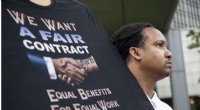FBI-agenter overvåger sociale medier. Efterhånden som trusler i hjemmet stiger, er spørgsmålet, hvem de ser på

Kredit:Pixabay/CC0 Public Domain
Den 11. august loggede Adam Bies ind på sin konto på Gab og begyndte at skrive:
"Jeg tror oprigtigt, at hvis du arbejder for FBI, så fortjener du at DØ."
Bies, 46, var en håbefuld freelancefotograf, der havde fyldt sin hjemmeside med actionbilleder af hurtige biler og udendørs sport. Han var blevet fyret fra sit daglige job inden for marketing for at nægte COVID-19-vaccinen, skrev han online, og havde kæmpet i sine bestræbelser på at indgive en arbejdsløshedsansøgning.
Som føderale anklagere senere ville beskrive i retssager, udfyldte Bies sine dage med at skrive under et pseudonym på Gab, en social medietjeneste populær blandt højreekstremister.
Hans indlæg indeholdt et link til en Fox News-historie om FBI-direktør Christopher Wray, der fordømmer bølgen af voldelige trusler rettet mod agenturet i de tre dage siden ransagningen af tidligere præsident Donald Trumps hjem og klub Mar-a-Lago. Han sammenlignede føderale agenter med nazistiske styrker. Han rystede over "politistatsskum". Og han komponerede, hvad der kunne have været set som en endelig plan.
"Jeg ved allerede, at jeg kommer til at dø i hænderne på disse ... retshåndhævende svindlere," skrev han, blandet med bandeord. "Mit eneste mål er at dræbe flere af dem, før jeg falder."
Fire dage senere omringede bevæbnede føderale agenter og SWAT-hold Bies' hjem, tæt på et væltende vandfald i det dybe skove jagtland i det vestlige Pennsylvania. Inde i huset var Bies og hans 12-årige søn. Det var mørkt, nær midnat.
Betjentene ringede til Bies på hans mobiltelefon, igen og igen, 16 gange i alt. De udstedte ordrer gennem en højttaler om at overgive sig.
Til sidst dukkede Bies op med en kampriffel. Betjentene beordrede ham til at lægge våbnet fra sig.
I de fire dage mellem Bies' truende indlæg og det øjeblik, han stod over for bevæbnede agenter, var han blevet fanget af en kompleks, lidet kendt praksis inden for FBI kaldet social media exploitation, eller SOMEX – en, der måske i dette øjeblik, overvåge onlineaktiviteterne for enhver i Amerika.
Top FBI-ledere har forsøgt at bagatellisere, i hvilket omfang agenter lovligt kan overvåge offentlige onlineaktiviteter for personer, der ikke er under undersøgelse. Men i virkeligheden kan bureauet udføre næsten ubegrænset overvågning af offentlige sociale medier, så længe det gør det til retshåndhævende formål, fortalte FBI-embedsmænd til U.S. TODAY.
Eksperter siger, at det giver FBI mere magt, end det har været villig til at anerkende offentligt – magt bureauet og andre sikkerhedseksperter siger, at de har et ansvar at bruge til at forhindre terrorisme.
Men kritikere siger, at udnyttelse af sociale medier også betyder, at agenter har lov til at gennemgå onlineopslag efter behag uden tilsyn, men alligevel store myndigheder.
"FBI embedsmænd har udsendt en masse misinformation om omfanget af deres myndigheder," sagde Michael German, en tidligere FBI specialagent og en stipendiat ved New York Universitys Brennan Center for Justice. "FBI har enorme beføjelser til at efterforske længe før der er et rimeligt kriminelt prædikat."
SOMEX, involverer agenter, der udvikler deres egne kundeemner og modtager information fra et netværk af kontrahenter og samarbejdspartnere, såsom en terrorforskningsgruppe, der først markerede indlæg fra Bies.
Men bureauet er blevet kritiseret for, hvordan dets efterforskere har reageret - som i tilfældet med onlineopslag lavet af liberale aktivister under Black Lives Matter-protesterne i 2020 - og hvordan de undlod at reagere - som i den højreorienterede opbygning til opstanden den 6. januar.
FBI har længe været under lup for overdreven rækkevidde ved oprettelse af filer om offentlige personer og andre, selvom de ikke var under kriminel efterforskning. Og nogle eksperter siger, at agenturet har en historie med at fokusere på venstreorienterede grupper som miljøforkæmpere og raceretfærdighedsaktivister, mens de ignorerer trusler fra hvide supremacister og andre på højrefløjen. De siger, at denne tendens bærer over i den digitale æra.
Og interne optegnelser opnået af en fortalergruppe ser ud til at vise agenter inden for cyberforskning, der specifikt fokuserer på anti-politi og raceretfærdighedsmøder i stedet for bevæbnede moddemonstranter eller hvide supremacister.
"Problemet med overvågning af sociale medier er ofte problemet med politiarbejde som helhed, som er, at politiet ikke kan forudsige kriminalitet, det eneste de kan gøre er at foretage en vurdering af, hvilken type person der er mest tilbøjelig til at begå kriminalitet, og sætte den gruppe under overvågning ," sagde Matthew Guariglia, en politikanalytiker ved Electronic Frontier Foundation. Denne "knæfaldsreaktion," sagde Guariglia, ender med at betyde mere overvågning og chikane af farvede og marginaliserede grupper.
Men da forargelsen over Mar-a-Lago nu ansporer trusler fra højreorienterede ekstremister til historiske niveauer, støder mangeårige spørgsmål om, hvordan FBI virkelig overvåger amerikanere online, en ny drejning:Hvad sker der, når de mennesker, der bliver truet, er FBI-agenterne selv?
FBI har bredere breddegrad, end mange er klar over
I juni sidste år, i en høring i Husets udvalg for tilsyn og reform, grillede New Yorks kongreskvinde Alexandria Ocasio-Cortez Wray over FBI's manglende evne til at forudse kaosset i oprøret den 6. januar.
"Vi ved nu, at angrebene var planlagt i det fri på populære sociale medieplatforme," sagde Ocasio-Cortez. "Inkluderer FBI regelmæssigt overvågning af sociale medier som en del af sine bestræbelser på at bekæmpe voldelig ekstremisme?"
Wrays svar var eftertrykkeligt:
"Vi har meget specifikke politikker, der har været i afdelingen i lang tid, som styrer vores evne til at bruge sociale medier. Og når vi har et autoriseret formål og korrekt forudsigelse, er der mange ting, vi kan gøre på sociale medier," sagde Wray . "Men det, vi ikke kan gøre på sociale medier, er uden ordentlige forudsigelser og et autoriseret formål, bare overvåg."
Måneder tidligere gav FBI's tidligere administrerende assisterende direktør for national sikkerhed, Jill Sanborn, en lignende forklaring til Senatets Komite for Hjemmeland Sikkerhed og Regeringsanliggender. "Vi kan ikke indsamle First Amendment-beskyttede aktiviteter uden en form for næste trin, som er hensigten," sagde hun.
Sen. Kyrsten Sinema fulgte op og spurgte:"Så FBI overvåger ikke offentligt tilgængelige samtaler på sociale medier?"
"Korrekt, frue. Det er ikke inden for vores myndigheder," svarede Sanborn.
FBI's egne regler siger noget andet.
FBI-embedsmænd fortalte U.S. TODAY, at Wrays udtalelse var korrekt, mens de anerkendte, at et "autoriseret formål" blot betyder at gøre hvad som helst i overensstemmelse med en FBI-agents pligter.
Det "autoriserede formål" er faktisk ekstraordinært bredt. Politik ville forbyde agenter at se på sociale medier for for eksempel at holde øje med en romantisk partner eller overvåge andre former for ikke-lovhåndhævelse. Men det ville give en agent mulighed for at se på stort set alt online, proaktivt, hvis hensigten var at stoppe en forbrydelse eller at holde amerikanere sikre. En FBI-embedsmand sagde, at dette faldt inden for "halvdelen af national sikkerhed, håndhævelse af føderal lov eller udenlandsk efterretningstjeneste."
German, a fellow with the Brennan Center's Liberty and National Security Program, argued in a recent report that individual FBI agents have extraordinary leeway to look through public-facing social media posts without seeking authorization from their superiors in advance or even keeping an official record of their actions.
The FBI rules, laid out in their handbook and periodically updated Attorney General's guidelines, allow agents to conduct "pre-assessments" of possible threats, German said. Those pre-assessments can be conducted "without any factual basis to suspect wrongdoing," German writes in his report.
He and several other experts agree that the FBI certainly can, then, proactively monitor Americans' social media for signs of unrest, dissent or violence that might lead to criminal activity.
FBI officials told U.S. TODAY this is correct. There's no need for "proper predication," or evidence of a crime, when conducting a pre-assessment of a subject.
German's analysis of the rules was echoed by Brian Murphy, a former top FBI official who helped pioneer the FBI's social media exploitation efforts.
He cited Sanborn's statements, telling U.S. TODAY, "I just think that she was wrong." He said the agency has a risk-averse culture that prevents agents and managers from taking the steps necessary to fully protect Americans.
Sanborn, who is no longer at the FBI, did not respond to messages seeking comment. An FBI spokesperson said Sanborn's comments referred specifically to "conversations" on social media and not to public-facing posts by individuals.
While the bureau describes its authorities carefully, its agents—and third party contractors—can track critics of the government like Adam Bies, watching until their online rantings cross a line into outright threats.
Then the FBI can act.
What SOMEX really looks for
The FBI's SOMEX team, which sits within the agency's National Threat Operations Center in Clarksburg, West Virginia, receives and investigates tips on imminent social media threats from concerned citizens, other law enforcement agencies, independent monitoring organizations and others.
But the effort involves more than just acting as a catcher's mitt for incoming tips. It also develops its own social media intelligence.
Documents obtained by the open-government group Property of the People (and first reported by Rolling Stone) give insight into the broader social media monitoring role SOMEX plays inside the FBI. The documents detail reports from the team to federal and local law enforcement in the Seattle area during the civil unrest that unfolded in the wake of the murder of George Floyd.
"While overnight social media activity was very light, the SOMEX team did find some tweeting by individuals stating they would monitor police radio activity," reads a typical extract from the documents, taken from a June 2, 2020 situation report emailed to dozens of FBI agents.
"The FBI aggressively scours social media for information related to topics of Bureau interest," said Ryan Shapiro, executive director and co-founder of the nonprofit group, which provided U.S. TODAY with hundreds of pages of documents about the FBI's social media monitoring that it acquired through open records requests. "This routinely includes surveillance of Americans who are not the subject of an investigation or even suspected of committing a crime."
In a statement, the FBI said that SOMEX was created to assist in identifying "unknown subject, victim, or location information" when there's a threat to life by using publicly available information. The team then forwards information to the appropriate agency for further investigation and appropriate action.
FBI officials told U.S. TODAY that agents are not allowed to use specific SOMEX tools without additional training in privacy and civil liberties protections. Those tools include commercial software the FBI purchases to use in-house. The FBI also works with third-party contractors for social media analysis, the officials said.
One contractor is the private intelligence firm the Hetherington Group, which has trained law enforcement and the military on conducting online investigations.
Cynthia Hetherington, the firm's founder and president, said the company identifies "actionable intelligence" that can be used to protect life or someone's reputation by helping those it trains learn how to hyperfocus and efficiently identify a key collection of terms that demonstrate legitimate threats, such as "kill," "die," "shoot," "fire," "bomb," "rob."
"Individuals should be allowed to say what they want to say on the internet, but should also understand that it's open source and the parties concerned will trace it back" to them, Hetherington said.
Another way of saying that, said Shapiro, who holds a doctorate from the Massachusetts Institute of Technology focusing on government surveillance, is that the FBI can, and is, monitoring practically whoever it wants, whenever it wants.
"The FBI is almost entirely unhindered in its ability to monitor American social media postings," Shapiro said, "So when the FBI reported to Congress that it was unable to do so—I mean, that is a bald-faced lie. That's what the bureau does. They lie."
As the FBI becomes more interested in specific posts, the bureau can also ramp up its monitoring in more "intrusive" ways, FBI officials said. With additional internal approvals, FBI agents can access not just public-facing social media, but also private groups and chat rooms.
Even when accessing this more private information, the FBI's internal checks don't protect Americans' civil liberties, several experts told U.S. TODAY.
The FBI has a long and troubled history of focusing on groups on the left of the political spectrum while largely turning a blind eye to domestic extremists on the far-right, said Guariglia, who holds a doctorate in the history of police surveillance.
"Both historically speaking, and in current events, we've seen the amount of surveillance that has been marshaled specifically against groups fighting for racial justice increased exponentially than from what we've seen being monitored on the right," Guariglia said.
The FBI pushed back on this assessment. "The FBI aggressively investigates threats posed by domestic violent extremists," a bureau spokesperson wrote in a statement. "We do not investigate ideology and we do not investigate particular cases based on the political views of the individuals involved."
Are there enough resources to do the work?
The FBI isn't the only law enforcement agency doing social media exploitation.
The bureau's SOMEX team is part of a constellation of social media analysis that has occurred across the national security apparatus over the few years. The Department of Homeland Security has its own SOMEX team plus social media analysts at dozens of "fusion centers" across the U.S. sharing intelligence with local, state and federal law enforcement, said Mike Sena, executive director of one of those fusion centers, the Northern California Regional Intelligence Center.
The FBI also works to train and assist local police departments in their social media exploitation efforts, a tactic that came to light earlier this year in a report by the Intercept, which detailed how the bureau provided the Chicago Police Department with fake social media accounts to investigate demonstrators outraged at the Floyd murder by police officers in 2020.
The San Bernardino terrorist attack in 2015 turned out to be a "proof of concept" on the efficacy of social media analysis, Hetherington said, when reporting from Facebook to a fusion center social media analyst helped the FBI quickly identify the people involved.
But using social media analysis to identify future crimes, rather than research past ones, is a broader net. That federal effort to prevent crimes is still small given the scale of the internet, Sena said.
"Most people would be shocked in America," Sena said. "There's a small number of folks trying to deal with these threats that are huge."
Sena and Hetherington told U.S. TODAY that after the ACLU of California publicized law enforcement's use of commercial software to "monitor activists and protesters" in 2016, many companies stopped selling their software to law enforcement or minimized their capacity to use it to track online activity.
As a result, Sena said, "our people are manually doing things, they're doing the work, but they're having to work 10 times as hard as they used to."
That's why agencies plan to bring their teams together, at least virtually, to break up siloes and avoid duplication, Sena said. One byproduct of this effort, he said, will be fewer blindspots or gaps that can be used to accuse law enforcement of bias.
"Even if you're being proactive, it's basically walking with a teaspoon at a river and trying to put that in a bucket," Sena said. "We're not getting everything, but it's better than nothing."
But German argues in his report that the majority of social media exploitation work is actually counterproductive. The sheer volume of tips generated by contractors and the FBI's own analysts results in an "information overload," German writes.
"Obviously, the multiple forms of social media monitoring that the FBI and other law enforcement agencies conducted prior to January 6 was not helpful in preparing for the attack," the report states. "Yet after the Capitol insurrection, the FBI invested an additional $27 million into social media monitoring software, effectively doubling down on a failed methodology."
Ongoing investment in social media exploitation
Those efforts continue even in the weeks since the Mar-a-Lago search and backlash.
Three days after the FBI executed its Aug. 8 search warrant on Mar-a-Lago and was inundated by right-wing threats, Ricky Shiffer, a 42-year-old Navy veteran, walked into the FBI office in Cincinnati armed with a nail gun and an AR-15 rifle.
As U.S. TODAY reported, Shiffer had spent the last nine days of his life ranting on Truth Social, the social media company founded by Trump. His hundreds of posts included explicit threats against the federal government including "Kill F.B.I. on sight."
When his attack failed, Shiffer fled north along rural highways and into a standoff where was ultimately shot and killed.
The FBI said in a statement that it had been informed of Shiffer but that "the information did not contain a specific and credible threat."
Wray told the agency in a message the day after that attack that the FBI's security division would be adjusting its "security posture accordingly."
A $32,400 contract approved Monday—after discussion that started weeks before the search of Mar-a-Lago, Hetherington said—notes that the agency will hire the Hetherington Group to train its agents on SOMEX later this month.
According to a document the bureau filed to justify making the purchase without opening it up to bidding, "it is an immediate need to expand and broaden the social media knowledge for the NTOS SOMEX team." The FBI wrote that the training can provide it with expertise in the "forces and factors that lead to the radicalization of terrorism specifically white supremacy extremism."
That document was filed Aug. 11, the same day Shiffer carried a nail gun into an FBI office, then fled into the Ohio cornfields.
It was also the same day Adam Bies was logging post after post on Gab.
'Why don't you send them my threats'
As Bies tapped out his messages, he wasn't just speaking to his 1,600 followers. According to court documents, he also deliberately tagged Gab founder Andrew Torba in his posts, goading him to report Bies to the federal government.
"Why don't you send them my threats so that they'd at least have something credible to show on Fox News," Bies wrote in the post. "Just scrub my timeline for the posts you didn't delete after you threatened to ban me."
Also watching Bies' posts was a third-party media monitoring and analysis firm, the Middle East Media Research Institute. MEMRI cut its teeth monitoring Middle Eastern media for English-speaking audiences, but over the last three years has expanded to real-time social media monitoring, specifically for threats from white supremacists and other homegrown extremists.
"We're consistently in communication with (law enforcement and government) agencies at the local, state and national level, and providing" them with actionable intelligence, said Simon Purdue, director of MEMRI's Domestic Terror Threat Monitor team. "Having people like us helps speed things along."
MEMRI alerted the FBI, according to a later criminal complaint. The FBI contacted Gab, who handed over Bies' subscriber information and Internet Protocol logs for his computer connection. Soon, agents were outside his Mercer County home.
After a 30 or 40 minute stand-off at his home, Bies eventually emerged carrying an assault rifle, an FBI agent testified in court. Agents told him several times to drop the weapon, which he eventually did.
Had he not done so, the agent testified, according to local media reports, "It would have ended differently."
Bies' son left the house safely. Inside the home, agents found 12 other guns and a compound bow. Bies was taken into custody and charged under a law that covers making threats against a federal law enforcement officer.
He has pleaded not guilty and is being held awaiting trial. + Udforsk yderligere
US plans for fake social media run afoul of Facebook rules
(c)2022 USA Today
Distributed by Tribune Content Agency, LLC
 Varme artikler
Varme artikler
-
 Ingen aftale:Bilarbejdere strejker mod GM i kontraktstridSean Crawford, af United Auto Workers 598, mødes uden for Marriott Renaissance Hotel, mens UAW GM Council holder møde inde på hotellet i Detroit, Søndag den 15. sept. 2019. United Auto Workers union m
Ingen aftale:Bilarbejdere strejker mod GM i kontraktstridSean Crawford, af United Auto Workers 598, mødes uden for Marriott Renaissance Hotel, mens UAW GM Council holder møde inde på hotellet i Detroit, Søndag den 15. sept. 2019. United Auto Workers union m -
 JAL lancerer lavprisselskab inden OL i Tokyo 2020JAL håber at kunne udnytte Tokyo 2020 til at øge sit lavprisudbud Japan Airlines (JAL) meddelte mandag planer om at starte et budgetflyselskab, i håb om at drage fordel af en forventet ekspansion
JAL lancerer lavprisselskab inden OL i Tokyo 2020JAL håber at kunne udnytte Tokyo 2020 til at øge sit lavprisudbud Japan Airlines (JAL) meddelte mandag planer om at starte et budgetflyselskab, i håb om at drage fordel af en forventet ekspansion -
 Ny Argonne supercomputer, bygget til næste generations AI, vil være mest magtfulde i U.S.A.Kredit:Argonne Den mest kraftfulde computer, der nogensinde er bygget i USA, får sit hjem i Argonne National Laboratory i 2021, det amerikanske energiministerium og Intel meddelte i dag. Aurora, U
Ny Argonne supercomputer, bygget til næste generations AI, vil være mest magtfulde i U.S.A.Kredit:Argonne Den mest kraftfulde computer, der nogensinde er bygget i USA, får sit hjem i Argonne National Laboratory i 2021, det amerikanske energiministerium og Intel meddelte i dag. Aurora, U -
 Israelsk højteknologi ser fremad-hvem der vinder stemmerDen israelske medstifter af navigationsappen Waze vises på en skærm i naturlig størrelse med råd om sin t-shirt:Forelsk dig i problemet, ikke i løsningen Inde i en lækker, skinnende bygning med ud
Israelsk højteknologi ser fremad-hvem der vinder stemmerDen israelske medstifter af navigationsappen Waze vises på en skærm i naturlig størrelse med råd om sin t-shirt:Forelsk dig i problemet, ikke i løsningen Inde i en lækker, skinnende bygning med ud
- De vigtigste skovbrande i Portugal under kontrol (opdatering)
- Spaniens naturbrand genoptages og truer naturparken
- Fakta om Pine Needles
- Giver sommerjob livslange fordele for teenagere?
- Quantum stopur gemmer tid i en kvantehukommelse
- Israel kan forvente et stort jordskælv på 6,5 på Richterskalaen i de kommende år


